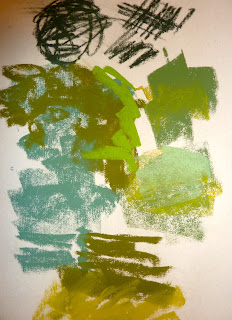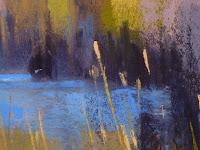 |
'Wander Here in Summer' 9x12 pastel ©Karen Margulis
sold |
Early morning and we were up looking for moose. Or Bear or Elk. Any creature would be just as exciting. It was chilly with dew on the grass. But the air was pure, crisp and exhilarating. The promise of another wonderful summer day and we wandered around taking photos.
So when it came time to finally paint this scene (which by the way is a fresh in my mind as the day I took the reference photo 3 years ago.) I needed to try to capture this mood. ..One of soft, cool quiet contemplation. That was my 'what'. Now I had to decide how I would accomplish that. start with my paper choice.
I chose a piece of Wallis sanded paper in Belgian Mist color. This is a nice medium gray surface that works well for anything. And it was already cut to size 9x12 so an easy choice.
I did a quick drawing with compressed charcoal. This keeps me loose yet committed. I like the charcoal when I want to be bold.
Now for the Block-In colors....I like the term Block in for the first layer of pastel instead of calling it an underpainting. Some think of underpaintings as being wet even though they aren't always wet so 'Block in' prevents this confusion.
 |
| Block in with cool colors...Nupastels |
I often write about block in colors and how they influence your color choice and the ultimate look of a painting. But so often we don't take the time to think about our first layer color choices and just start right in with the local colors we see. We are missing out on an opportunity to make our paintings more interesting.
I often choose warm block in colors...reds and oranges... when I have a very green landscape. It introduces the excitement of the complement but it also lends a sunny warm feeling to the painting.
For this painting I wanted a cool crisp mood and not warm and sunny. So this time I chose cool colors for the block in. I used blues and purples and a bit of red purple. These are all good colors to lend a touch of cool to my scene. I also ended up using a lot of cooler greens and purples in the top layers.
If I had used warm colors for my block in the mood would have been different! Take time to think about how the colors of your block in layer will effect the rest of the painting!
Anyone care to guess where this landscape is?


















































